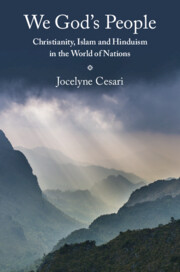Book contents
- We God’s People
- We God’s People
- Copyright page
- Dedication
- Epigraph
- Contents
- Figures and Tables
- Acknowledgments
- Note on Transliteration and Italicization
- Introduction
- 1 Framing the Question
- 2 State, Islam, Nation and Patriotism: Never-Ending Tensions
- 3 The Nexus of Secularism and Communalism, or Hinduism as a Political Project
- 4 Religion and the Transcendent State in China
- 5 Orthodoxy: Between Nation and Empire
- 6 Patterns of Religion-Politics Interactions
- Conclusion
- Bibliography
- Index
1 - Framing the Question
Published online by Cambridge University Press: 11 December 2021
- We God’s People
- We God’s People
- Copyright page
- Dedication
- Epigraph
- Contents
- Figures and Tables
- Acknowledgments
- Note on Transliteration and Italicization
- Introduction
- 1 Framing the Question
- 2 State, Islam, Nation and Patriotism: Never-Ending Tensions
- 3 The Nexus of Secularism and Communalism, or Hinduism as a Political Project
- 4 Religion and the Transcendent State in China
- 5 Orthodoxy: Between Nation and Empire
- 6 Patterns of Religion-Politics Interactions
- Conclusion
- Bibliography
- Index
Summary
The worldwide exportation of the nation-state went hand in hand with the diffusion of the Western concept of religion, both of which are notably related to the expansion of the Westphalian order. Exploring the diffusion of the twin concepts of nation-state and religion intersects with two bodies of knowledge: nationalism and secularization. Combining them helps explain why and how religion and politics influence each other. Historical institutionalism and conceptual history are used to establish areas of politicization of religion in the qualitative phase of the research and to identify patterns in big data bases in the quantitative phase of the research. This approach is applied to the politicization of religion in Syria, Turkey, India, China and Russia.
Keywords
- Type
- Chapter
- Information
- We God's PeopleChristianity, Islam and Hinduism in the World of Nations, pp. 9 - 27Publisher: Cambridge University PressPrint publication year: 2021

